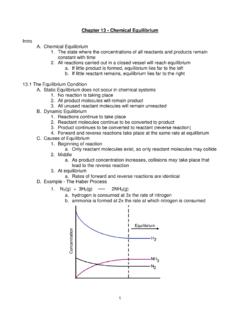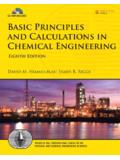Transcription of The Rate of a Chemical Reaction - VDOE
1 Science Enhanced Scope and Sequence Chemistry virginia department of education 2012 1 The Rate of a Chemical Reaction Strand Nomenclature, Chemical Formulas, and reactions Topic Investigating Chemical reactions and equations Primary SOL The student will investigate and understand how conservation of energy and matter is expressed in Chemical formulas and balanced equations. Key concepts include f) Reaction rates , kinetics, and equilibrium. Related SOL The student will investigate and understand that experiments in which variables are measured, analyzed, and evaluated produce observations and verifiable data. Key concepts include a) designated laboratory techniques; b) safe use of chemicals and equipment; c) proper response to emergency situations.
2 Background Information Chemical kinetics is the study of rates of Chemical reactions and Reaction mechanisms when and how fast a Chemical Reaction occurs. Many factors influence Reaction rate. Two of the most important are the nature and properties of the reactants themselves, including particle size (surface area). Other factors, such as concentration, temperature, pressure, or the presence of a catalyst, will also affect the rate of a Reaction . Collision theory can explain how these factors affect Reaction rate. Collision-theory concepts: For a Chemical change to occur, old bonds must be broken (an endothermic process) and new bonds must be formed (an exothermic process).
3 The reactants must collide with each other to form products. The reactants must collide with each other at the correct angle and the correct molecular orientation. The collisions between reactants must be effective , they must have enough energy (called activation energy ). Activation energy is the minimum energy needed for a Reaction to occur. If the rate of collisions increases, the Reaction rate increases. Anything that increases the chances of collisions between reactants also increases the number of collisions that are effective. If the percentage of effective collisions increases, the Reaction rate increases. Effect of concentration on Reaction rate: An increase in the concentration of reactants results in an increase in the Reaction rate.
4 At higher concentrations, the molecules of the reactants are closer to each other; therefore, collisions occur more frequently, a higher percentage of collisions are effective, and the Reaction rate increases. Science Enhanced Scope and Sequence Chemistry virginia department of education 2012 2 Effect of surface area on Reaction rate: In a solid, only surface particles can interact with the other reactants. If the solid is divided into smaller pieces, then there is greater surface area; therefore, more particles are able to react, and the Reaction rate increases. Effect of temperature on Reaction rate: An increase in the temperature of reactants usually results in an increase in the Reaction rate.
5 At higher temperatures, the molecules of the reactants move faster; therefore, collisions occur more frequently, a higher percentage of collisions are effective, and the Reaction rate increases. A general rule of thumb is that on average, the Reaction rate doubles for every 10 C rise in temperature. Effect of a catalyst on Reaction rate: A catalyst is a substance that changes the Reaction rate without being consumed by the Reaction . A catalyst acts by lowering the activation energy required for a Reaction to take place, thus allowing the Reaction to occur more rapidly. Materials Test tubes Ice water bath Hot water bath Distilled water 250-mL plastic bottle Steel wool Test tube rack Five 250-mL beakers M, M, M, and M HCl solutions Small pieces of zinc Powdered zinc 3% H2O2 solution M CaCl2 solution M NaCl solution M FeCl3 solution M KNO3 solution M Fe(NO3)
6 3 solution Alka-Seltzer tablets Safety goggles Vocabulary activation energy, catalyst, Chemical Reaction , collision theory, concentration, constant temperature, endothermic, equation, exothermic, ion, kinetics, molecule, particle, Reaction rate Science Enhanced Scope and Sequence Chemistry virginia department of education 2012 3 Student/Teacher Actions (what students and teachers should be doing to facilitate learning) Introduction 1. Ask students if the rate of a Chemical Reaction depends on the ability of molecules or ions to make consistent and effective collisions with each other. In this experiment, you will study various conditions and the effect they have on the collision of molecules.
7 You will observe the effects of temperature, concentration, particle size (surface area), and catalysts on the rates of Chemical reactions and then explain these effects in terms of the collision theory. Procedure Experiment 1: Effect of Temperature on Reaction Rate 1. Pour about 5 mL of M HCl into each of three clean test tubes. Place one of the tubes in an ice water bath maintained at 0C. Place another in a hot water bath maintained at 60C. Maintain the third test tube at room temperature. Allow about 10 minutes for the tubes to reach equilibrium temperature. 2. Cut three small pieces of zinc to the same size ( cm). Clean the pieces with steel wool, if necessary.
8 Ask students why they would need to treat some pieces of zinc with steel wool and why others may not need it. 3. Note the time, and drop one piece of zinc into each of the three test tubes. 4. Watch the reactions , and note the time at which each Reaction ceases. Which Reaction was fastest? Which was slowest? Experiment 2: Effect of a Catalyst on Reaction Rate 1. Measure 90 mL of distilled water into a clean 250-mL plastic bottle, and add 10 mL of 3% H2O2. Label the solution as H2O2. This will be your test solution. 2. Rinse six clean test tubes and a 10-mL graduated cylinder with the H2O2. Discard the rinsing. 3. Measure 5 mL of the H2O2 solution into each of the six test tubes, and place them in a test tube rack.
9 4. Add 5 drops of each of the following solutions to separate test tubes of H2O2: M CaCl2 M HCl M NaCl M FeCl3 M KNO3 M Fe(NO3)3 5. Ask students to set up a method for determining rate of gas evolution for each test. 6. Observe each solution, and report the rate of gas evolution from each, using the terms fast, slow, very slow, or none to describe the rate. Describe the catalytic effect as high, low, or none. Experiment 3: Effect of Concentration on Reaction Rate (at Constant Temperature) 1. Pour 5 mL of each of the following HCl solutions into separate clean test tubes: Science Enhanced Scope and Sequence Chemistry virginia department of education 2012 4 M M M M.
10 2. Cut four small pieces of zinc (1 1 cm). Clean with steel wool, if necessary. Drop a piece of zinc into each of the acid solutions, and record the starting time and the ending time of each Reaction . Compare the Reaction times. Which was fastest? Which was slowest? Experiment 4: Effect of Particle Size or Surface Area on Reaction Rate 1. Cut a piece of zinc ( cm). Clean with steel wool, if necessary. 2. Determine the mass of the zinc to the nearest g and record. 3. Place the piece of zinc in a clean, dry test tube. 4. Measure an equal mass of powdered zinc into a second clean, dry test tube. 5. Place both test tubes in a rack, and add 5 mL of M HCl to each.














